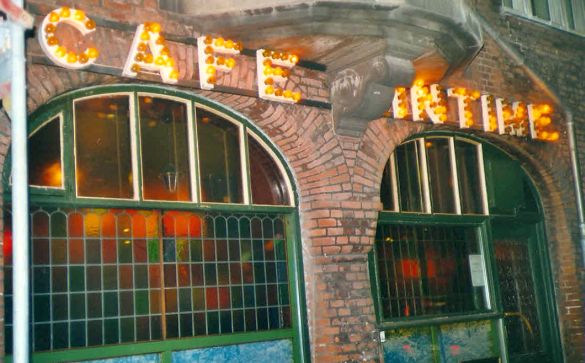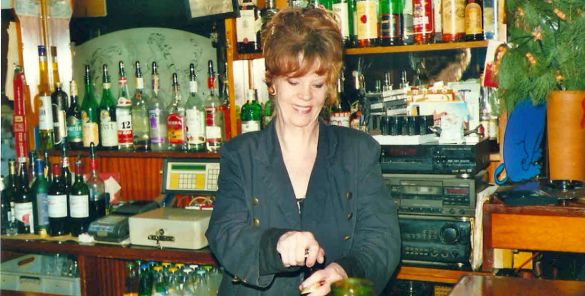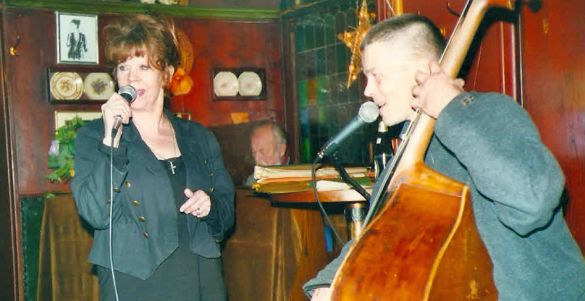No sooner are you in Copenhagen, Denmark’s capital city, then its name suddenly changes to Frederiksberg; a municipality within and encircled by Copenhagen. The posh Frederiksberg boasts a City Hall of its own, near which there is a place where time has nearly stood still – Café Intime.
Calling Frederiksberg Copenhagen, that’s okay, but calling Intime a café, is a bit pretentious. It’s a bar, discreetly placed in Allégade 25 behind a narrow park. The assembly rooms next door are not part of it, but the whole thing apparently started out as the Wine Restaurant Intime, its first license dating back to 1922. The unsteady sign outside is of younger date, revealing that Intime stays open from 18 to 02.
The arched stain glass windows keep the daylight out, but fail to keep the piano music inside though, in the only true piano bar around. Newcomers enter with a definite feeling of deja-vu, not quite aware that they are traveling backwards in time to a prenatal condition.
Deep-red walls, green-black ceiling, cozy nooks and crannies, knick-knacks on every shelf, enveloped in a patina of tobacco smoke, soft lighting and nostalgic tunes, the old-fashioned place greets and engulfs you – like a womb.
Friday and Saturday nights are busy, Sunday evening offers jazz, other nights used to be more quiet until Lars, the owner during the past three years, organized performance by the customers themselves twice a week. Intime is still no bonanza and has changed hands repeatedly, each time creating stress among the regulars; they fear major changes. Fortunately, Intime’s petite size seems to have a preserving effect.
Lars is a good man for Intime. He has smartened it up without changing the basic ambience, installed a badly needed ventilation system, and is also very active attracting musicians to the place, although the limited floor space hardly allows a band and an audience simultaneously.
If you ask Lars whether Intime is a men’s bar, he becomes a diplomat and gives you an all-inclusive answer. The two ladies pictured on the wall behind the grand piano – both of them dead now – would have answered likewise. But Intime is not exactly the peaceful place they used to know, its nostalgia has become trendy among young couples, some get so excited that they want to write a book about it.
Oda and Monica
The elder lady on the wall is Oda who played the piano ages ago – tunes of joy and sentimentality, generated by gnarled old fingers. Her dresses were like historical theater costumes, their heaviness kept her warm. In the wise eyes of Oda, there was a magic sense of romance, making her an excellent matchmaker. She had her favorites and each had his own special song played, a seldom honor among the ladies.
Late in life, in her 80s, Oda became a gramophone star and can still be heard on the radio decades after her death, reciting with a smile in her voice.
The picture at the top is a drawing of a lady singer, it has a striking resemblance to Monica – bartender, owner and entertainer, all wrapped in one. Monica was from Sweden, jazz was her favorite genre, and her husband’s band had kept her busy. His early death brought Monica to Café Intime. That was a period of continuity, 12 years during which Intime lived a stable life, supported by Monica’s many friends and fans.
Blessed with a large repertoire, she asked with natural confidence, “What would you like to hear?” I used to suggest Oda’s signature song, it would have come anyway:
“I love you
because your nature flutters
toward me
like a candle in the draught
I love you
for when I believe I’ve got you
then the candle goes out
and you are gone”
The conversation normally took a break as long as Monica was singing. Noisy customers got a sharp look or a reproving tap on her microphone. In search of a foundation for her home-made drum – merely an empty pizza box – she asked people to lend her a corner of their table. Monica always returned to the bar after three songs, leaving the entertainment to Palle, who could match any atmosphere through his piano keys.
Monica was a guarantee against change, simply because she could not afford it. Nevertheless, the lady in black became an institution, whom media took an interest in from time to time, causing a minor renaissance for Intime, even though it was short-lived. Health problems forced Monica to sell. She could still be seen and occasionally persuaded to sing on the Sunday jazz evenings where her son played the double bass.
New Winds
Three years ago, Monica died and was buried on a Saturday afternoon. After the funeral, people gathered in Intime. Talented voices, several of them professionals, formed a memorial to Monica with their songs. A fellow regular appeared in the evening. “I buried my father today”, he told me. Hearing about Monica, he resolutely went up to sing, “Colorful celebration, that’s my memory of you!” Little by little, the spirits grew lighter, customers filled the room and in Intime was business as usual.
Oda is the main milestone in the history of Intime. Whenever people come and say they were here years ago, the regulars ask them, “You know Oda?” For in that case we really have something in common. Monica, too, has now become a milestone. “You met Monica?” People wonder why we orientate ourselves around these two ladies – they were synonymous with Intime, part of its identity. And we did like them a lot.
With these milestones, the future of Intime should be secured, in that they serve as links to the old days. Ole, the Saturday night piano man, keeps their songs alive and takes us through the whole Danish operetta repertoire with his trained voice. He is the right man in the right place, also when Sandra and Tusnelda, two aging drags, do their show. The elegant Tusnelda forgets the words – we gladly prompt her. The pride of Sandra, her supple silicone attachments, surely promotes the sale of the 70-year-old’s autobiography, exhibited on the bar desk and in every book shop.
Small is beautiful, now that the government has imposed a smoking ban – Intime is too small to be comprised. Other new winds occur, like occasional media exposure, also nourished by Intime’s inexhaustible resource: the gender theme. On a busy night, the categories are very eclectic: music lovers and nostalgists; a birthday or stag party; the zoo crowd, only there to study the particular species they heard stories about; and the regulars of course, increasingly grumpy when no bar stool is waiting for them. The present disturbances are not significant in the long run, so Café Intime surely remains a pocket of timelessness – on Frederiksberg or in Copenhagen – as you like.
More reading: Top 5 Attractions in Copenhagen


